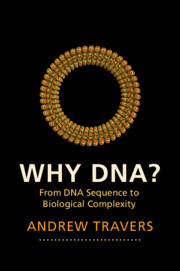-
Select format
-
- Publisher:
- Cambridge University Press
- Publication date:
- May 2022
- February 2022
- ISBN:
- 9781107297241
- 9781107056398
- 9781107697522
- Dimensions:
- (228 x 152 mm)
- Weight & Pages:
- 0.5kg, 222 Pages
- Dimensions:
- (228 x 152 mm)
- Weight & Pages:
- 0.4kg, 222 Pages
- Subjects:
- Genetics, Life Sciences, Evolutionary Biology
You may already have access via personal or institutional login- Subjects:
- Genetics, Life Sciences, Evolutionary Biology
Book description
Information is central to the evolution of biological complexity, a physical system relying on a continuous supply of energy. Biology provides superb examples of the consequent Darwinian selection of mechanisms for efficient energy utilisation. Genetic information, underpinned by the Watson-Crick base-pairing rules is largely encoded by DNA, a molecule uniquely adapted to its roles in information storage and utilisation.This volume addresses two fundamental questions. Firstly, what properties of the molecule have enabled it to become the predominant genetic material in the biological world today and secondly, to what extent have the informational properties of the molecule contributed to the expansion of biological diversity and the stability of ecosystems. The author argues that bringing these two seemingly unrelated topics together enables Schrödinger's What is Life?, published before the structure of DNA was known, to be revisited and his ideas examined in the context of our current biological understanding.
Awards
Winner, 2023 Choice Awards
Reviews
‘The essence of the book is in its title. The DNA structures and topology are described so clearly that the reader perceives these intricacies as pure evolutionary elegance, and understands WHY it is only in its balance of stability and agility that life could have started its journey. This book explains how DNA has become the fascinating prism, made of a fabric of complexity and information, into which the living reflects itself. My opinion is passionate because I have been thinking about the same problems for decades, and here I find many of the answers. Especially: what makes DNA so unique? It is a text that I keep reading over again.’
Ernesto Di Mauro - IBPM, National Research Council, Rome
‘In What Is Life? Schrödinger conjectured that, in animate matter, order is derived from order, foreshadowing the discovery of DNA structure. Why DNA? is about this molecule and its dual information content - in linear genetic code and in thermodynamics of three-dimensional DNA structures. It addresses how DNA’s intrinsic order led to complex, highly ordered living organisms, in a world that strives towards disorder. Why would DNA supplant RNA in carrying hereditary information during biological evolution? Why did multicellular organisms emerge, since natural selection favours the fittest, such as simple bacteria? What is complexity, and what has it to do with Bayesian logic? How do complexity, information and energy interrelate? This is a succinct discourse on Schrödinger’s question, expanding from molecular interactions and genome cooperation to ecological systems and societal evolution. A must-read for biology scholars, and anyone interested in life’s origins, biological evolution and the interface of biology and physics.’
Georgi Muskhelishvili - Agricultural University of Georgia, Tbilisi
'This is a welcome, fresh discussion of DNA as a complex biochemical resource beyond genetic functions. … Highly recommended.'
D. L. Beach Source: Choice
Contents
Metrics
Altmetric attention score
Full text views
Full text views help Loading metrics...
Loading metrics...
* Views captured on Cambridge Core between #date#. This data will be updated every 24 hours.
Usage data cannot currently be displayed.
Accessibility standard: Unknown
Why this information is here
This section outlines the accessibility features of this content - including support for screen readers, full keyboard navigation and high-contrast display options. This may not be relevant for you.
Accessibility Information
Accessibility compliance for the PDF of this book is currently unknown and may be updated in the future.



